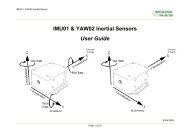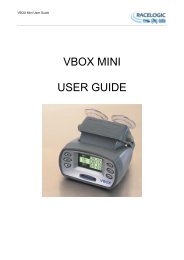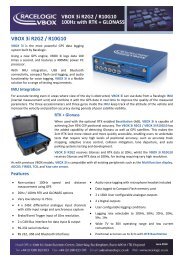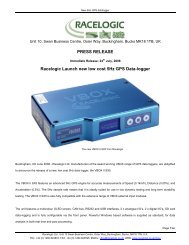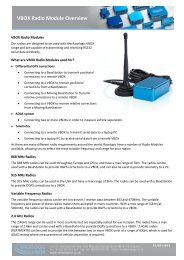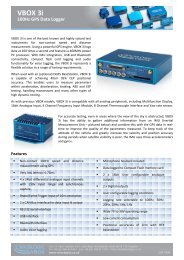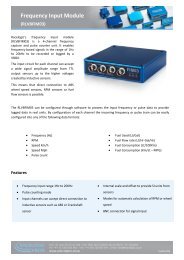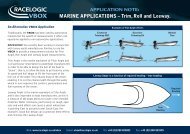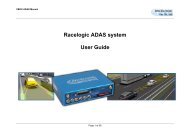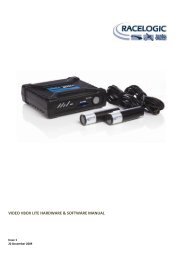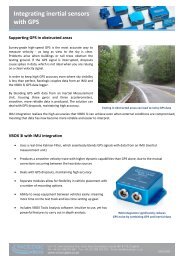Advanced Circuit Driving Techniques - Racelogic
Advanced Circuit Driving Techniques - Racelogic
Advanced Circuit Driving Techniques - Racelogic
You also want an ePaper? Increase the reach of your titles
YUMPU automatically turns print PDFs into web optimized ePapers that Google loves.
<strong>Advanced</strong> <strong>Circuit</strong> <strong>Driving</strong> <strong>Techniques</strong><br />
Article 9: Finding time in the wet<br />
Using a predictive lap timer to go faster in the wet<br />
<strong>Driving</strong> quickly on a wet track sometimes requires a<br />
very different technique compared with driving in the<br />
dry. Depending on the track, the quickest line through<br />
the corners may differ substantially from the accepted<br />
dry ‘racing line’.<br />
The wet line myth<br />
It is often quoted that the racing line becomes coated<br />
with rubber and oil which makes it more slippery in<br />
the wet. However plausible this sounds, it is in fact a<br />
myth and here is why:<br />
When asphalt is first laid down, there is a uniform<br />
roughness to the surface. Over the years, as many cars<br />
pass over the same piece of road, the sharp ridges<br />
and peaks in the road surface become worn down to a<br />
smooth surface.<br />
Close up of tarmac<br />
worn smooth after 8<br />
years of heavy use<br />
If you look next time you are on track, (assuming<br />
it is sunny!) you will see that the track surface on<br />
the racing line is ‘shinier’ compared with the rest of<br />
the track.<br />
Off the racing line, it is the sharp ridges and peaks<br />
which yield greater grip in the wet than the smoother,<br />
more frequently used parts of the track.<br />
Why is this?<br />
The two dominant forces affecting the performance<br />
of a tyre are adhesion and deformation. Adhesion is<br />
the chemical ‘stickiness’ between the tyre and the<br />
track, and deformation is the force which results from<br />
the rubber changing shape to fill in the gaps in the<br />
surface.<br />
With adhesion, the more direct contact there is<br />
between the tyre and the track, the greater the force.<br />
Smooth surface<br />
Good adhesion + Poor deformation<br />
= good grip in dry<br />
With deformation, the more distortion of the tyre<br />
there is, the greater the force.<br />
Rough surface<br />
Poor adhesion + Good deformation<br />
= good grip in wet<br />
Adhesion generally has a stronger effect than<br />
deformation, so in the dry, once the tyre is up to<br />
temperature, a smooth surface will generate better<br />
grip than a rough surface.<br />
www.VideoVBOX.co.uk<br />
However, a wet surface prevents direct contact<br />
between the rubber and the surface, completely<br />
blocking the formation of the adhesive forces that<br />
work best on flat surfaces. Therefore, in the wet,<br />
a rough surface can generate far more grip by<br />
increasing the deformation of the tyre.<br />
Another important factor is the tyre temperature, as<br />
cold tyres have inherently less grip than warm tyres.<br />
In the wet, it is often difficult to get tyre temperatures<br />
high enough to give good grip.<br />
How to find the wet line (or wettest line)<br />
Unfortunately, there is no magic formula to working<br />
out the ‘wet line’ through a corner, the only way is<br />
through trial and error, and this is where a predictive<br />
lap timer becomes an essential part of the process.<br />
Here are some tips from Nigel Greensall, (highly<br />
experienced driver coach) on finding the grip on a wet<br />
and slippery track:<br />
• Get some temperature into the tyres<br />
I find it is important to work the tyres hard straight<br />
from the pits. I try and slide the car around to<br />
move the tread blocks about to generate some<br />
heat. However, there is no point trying to do this on<br />
the greasy parts of the track, as you won’t be able<br />
to generate enough g forces to have an effect, so I<br />
drive around the edges of the track trying to find<br />
some grip.<br />
It is only once the tyres are up to temperature that<br />
you can properly begin to find what the quickest<br />
line will be.<br />
57




